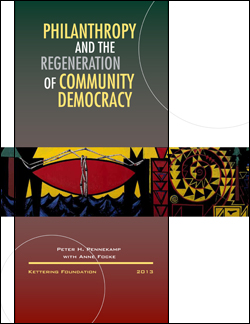Philanthropy and the Regeneration of Community Democracy
Peter H. Pennekamp with Anne Focke. 2013, 34 pages, Kettering Foundation, Dayton, Ohio, Washington, D.C., and New York, kettering.org.
Philanthropy and the Regeneration of Community Democracy is a retelling and analysis of the experience of Humboldt Area Foundation (HAF) between 1994 and 2012 in Humboldt County, California, during and after what the report refers to as the “Timber Wars.” By extension, it also suggests that foundations willing to take the risk of becoming “staging grounds” for community democracy can see the kind of systems change that is “often a target of large philanthropies.” The authors caution that “changing a culture takes time and the timing tends to be unpredictable,” while large foundations tend to reward timeliness and predictability.
By creating a community commons where people felt safe, HAF took itself out of the foundation’s “expert” role and lived out the notion that good ideas come from everyone. By addressing the discomfort the James Irvine Foundation felt about the lack of returns in the first year of a multiyear $1.25 million grant, the Humboldt Area Foundation was able to make a contribution to economic recovery in a deeply conflicted process of job loss and environmental concern.
Despite turning down a Ford Foundation grant for “training and peer learning from the Aspen Institute’s Community Strategies Group” (19) in 1988 — HAF felt the required fund-raising would divert energy and “scarce staff time from community engagement and action” (ibid.) — they were later invited to participate in the Aspen program, and “Ford became a significant contributor to cultural organizing” (ibid.) in the region’s American Indian communities.
Five operating principles are illustrated through various aspects of several stories. The authors describe these principles as “the stars by which Humboldt Area Foundation has charted the course of its development as a community philanthropy” (15).
- The principle “Dynamics of Difference” is told about through the UIHS facility in Arcata called Potawot Health Village. When the facility was proposed, it was met with prejudice in Arcata. The city council apologized to the nine tribes that comprise UIHS. When built, the facility doubled the number of American Indians served. Three years after the opening, the Eureka City Council returned land to the Wiyot tribe on an island (Tuluwot) in Humboldt Bay.
- Community Assets is illustrated in the context of the yearlong process in which timber owners and environmental leaders met to reduce conflict and build trust. The “Headwaters Fund,” created to compensate Humboldt County for the loss of taxes involved in creating a state preserve, became a community-controlled fund. Proposals are open to all, as suggested by the timber owners and environmental activists who signed an ad that also indicated that fund management would not be open to any self-interested party. Since HAF designed the ad that stated the guidelines and restrictions, it later turned down management of the assets. The fund continues “to grow in importance and impact.” The story of continuing community benefit is in sharp contrast with the Quincy Library Group in which a timber industry forester, a county supervisor, and an environmental lawyer met in secret, spent close to $82 million in Forest Service funds, and created a plan with dubious benefits to the areas around Lassen, Plumas, and parts of the Tahoe National Forest in California.
- Community Commons describes the flexible and transparent community forums required to tap into the community’s knowledge.
Outcomes included:- Redwood Coast Connect, a policy leader in broadband deployment
- Renewed and inclusive focus on regional economic development and community forestry (50,000 acres set aside)
- Institute of the North Coast Redwood Coast Rural Action
- California Center for Rural Policy research center at Humboldt State University
- Time and Convergence points out the ways in which community interests and actions occur on a different timetable from that of foundations and suggests the need for all to calibrate “expectations for outcomes to a community’s pace of change.”
- Essential Infrastructure is about the requirement for a place to meet, skill in organizing meetings and facilitation, a copy machine to print meeting notices for those without computers, availability of translation, child care, and transportation in order to “generate something close to engagement.”
The authors define community democracy as “grassroots engagement where people uncover, activate, and energize their community’s own assets, take responsibility for their formal and informal decision-making processes, and further their ability to work constructively with conflict and difference” (15).
For philanthropists interested in fostering structural change and building community democracy, the following seven principles may be helpful:
- Civic capacity
- Horizontal relationships
- Citizen agency
- Impartiality
- Equalizing infrastructure
- Flexibility
- Democracy is where you find it.
The writers suggest that philanthropy may have a huge role to play in building community democracy and that it must be willing to provide commons, structure, some guidance and money, and patience as the process develops in ways that may be neither hierarchical nor comfortable for foundations. In order to benefit from the flexibility, understanding, creativity, and collaboration of engaged individuals, foundations may need to let go of the outcome — at least for a while.

